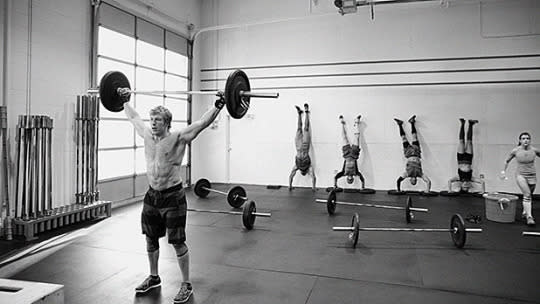Signs You're Sabotaging Your Strength Workout

(Photo Courtesy of Getty Images)
You do sit-ups for your abs, but if your muscles aren’t firing right, your abdominals get the day off while your hip flexors do all the work. To know when a move is off and get the most out of your workouts, you have to pay attention to body feedback. Your body gives you all kinds of signs — sore hip flexor, tight shoulder, knee cramps — as you exercise and move through day-to-day life. If you’re able to interpret what your body is telling you, you will be able to adapt workouts to better target the muscles that need the most work. Start with these three classic exercises. You’ll see the most common signals the body gives that something is wrong, and how to correct them.
Related: The Only 8 Moves You Need to Be Fit
Push-ups
The symptom: You feel pinching at the front of your shoulder or tightness at your upper traps while lowering and/or pushing up.
The body signal: The ball of your humerus (arm) is not positioned properly in the shoulder socket (scapula). This means your shoulder isn’t fully stabilized.
How to fix it: The classic push-up primarily targets your pecs, but because it’s essentially a moving plank, you engage both stabilizing and moving muscles. Your pecs are the primary mover while your core stabilizes. When you do push-ups you should actually feel the muscles surrounding your shoulders working in addition to your abdominals, glutes, and quads. To ensure a stable position, try push-ups with your hands rotated inward so your fingers point back toward your feet with your elbows tucked in at your sides. And when performing a regular push-up, try to pinch your shoulder blades together without shrugging them up toward your neck.
Related: 10 Ways to Do a Push-Up
Sit-ups
The symptom: Feeling the muscles in your lower back and hip flexors working instead of your abdominals.
The body signal: Your abdominals are not contracting properly because your ribs are flared or your pelvis has an anterior tilt (read how to fix that here). This causes you to overuse your hip flexors, and in turn, will pull on the lumbar spine to create excess tension in your low back.
How to fix it: Breathe out forcefully — imagine you’re blowing out candles — when you’re doing sit-ups. This is the reflexive way to engage you transverse abdominis, your deepest abdominal muscle. To further strengthen your core and ensure it fires correctly, do planks and side planks prior to sit-ups. Firing up the core muscles from a face-down and side position will help your abdominals do the lifting (instead of your hip flexors) when you go back to sit-ups.
Related: 14 Moves That Are More Effective Than Sit-Ups
Squats and Lunges
The symptom: Your feet cramp during lunges and squats.
The body signal: The bottom of your foot (plantar fascia) is taking on too much force, likely because you’re placing all of your weight on the ball of your foot.
How to fix it: If you do everything on the ball of your foot it will eventually cramp because you are not allowing it any rest. Before sets of lunges or squats, remind yourself to put your weight in your heels, while still keeping toes flat on the ground. If you do cramp, one way to relieve it is to release the soleus and then plantar fascia (instructions below).
Related: 4 Foolproof Ways to Fix Your Squat Form
Soleus Release
Sit with your calf on top of the lacrosse ball.
Place your other leg over the one you are releasing and roll yourself up and down over the ball.
Once you find a spot that is tender, stop and point your foot up and down for 30 seconds.
Plantar Fascia Release
Stand with a lacrosse ball or golf ball placed under the bottom of your foot; gently roll the ball from front to back of foot.
Once you find a spot that is tender, stop and point your toes up and down.
Roll on the ball for one to two minutes.
By David Reavy
More from Men’s Journal:
The 10 Moves You Need to Get a Rock-Solid Core
